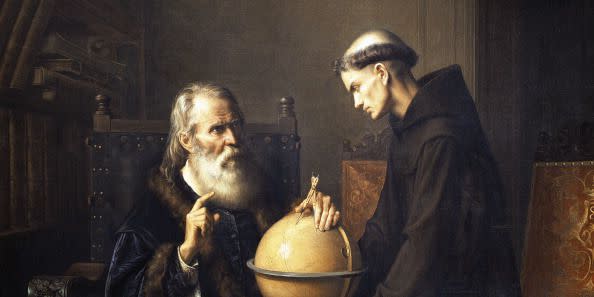Newfound Galileo Letter Suggests He Lied to Dupe the Church and Avoid Persecution

Aside from his many contributions to the evolution of modern science, Galileo Galilei is also famous for defying the 17th century Catholic church. He's lionized for advocating a heliocentric view of our solar system, spurning Church doctrine and becoming a heretic. But a new discovery presents an interesting wrinkle in the Galileo narrative.
A new report in Nature suggests Galileo acted out of an abundance of caution while quarreling with the Inquisition, watering down his rejection of the church's geocentric model of the universe in a letter dated December 1613. Writing to his friend, the mathematician Benedetto Castelli, Galileo first outlined his rejection of Church dogma and its overbearing influence on the Copernican theory that Earth revolved around the sun. As with many of Galileo's writings, several duplicates of this letter were printed and circulated, causing a watershed moment in scientific history known as the "Galileo Affair."
It's at this point, however, that the story gets tangled. Two copies of this letter have survived to present day. A more inflammatory version was sent to the Inquisition by a friar named Niccolò Lorini in 1615, causing a furor that deeply upset religious authorities. Galileo insisted the harsher version had been doctored by the Church so it could prosecute him under heresy charges, and for centuries, historians couldn't be sure if this was true. According to the new discovery, though, researchers are more certain than ever that it was Galileo who lied to save himself.
The new letter, lost because of an egregious filing error and finally discovered at London's Royal Society, was sent by Galileo to the Roman cleric Piero Dini after the more aggressive missive caused a stir in 1615. Galileo insisted it was the correct letter, and that the prior note had been nefariously altered by the Inquisition in order to malign him.
Science historian Salvatore Ricciardo of the University of Bergamo discovered the new letter in August, and subjected it to a rigorous analysis. A few key indicators suggest the letter is definitely Galileo's work. The 7-page document is signed "G.G.," and the handwriting matches many of the scientist's other letters.
In this tempered version, many of the more ardent passages are altered with mark-ups and edits. Nature explains how Galileo weaved in multiple euphemisms:
In one case, Galileo referred to certain propositions in the Bible as “false if one goes by the literal meaning of the words”. He crossed through the word “false”, and replaced it with “look different from the truth”. In another section, he changed his reference to the Scriptures “concealing” its most basic dogmas, to the weaker “veiling”.
Ricciardo's findings will be published in the Royal Society journal Notes and Records once the letter is fully parsed.
('You Might Also Like',)
